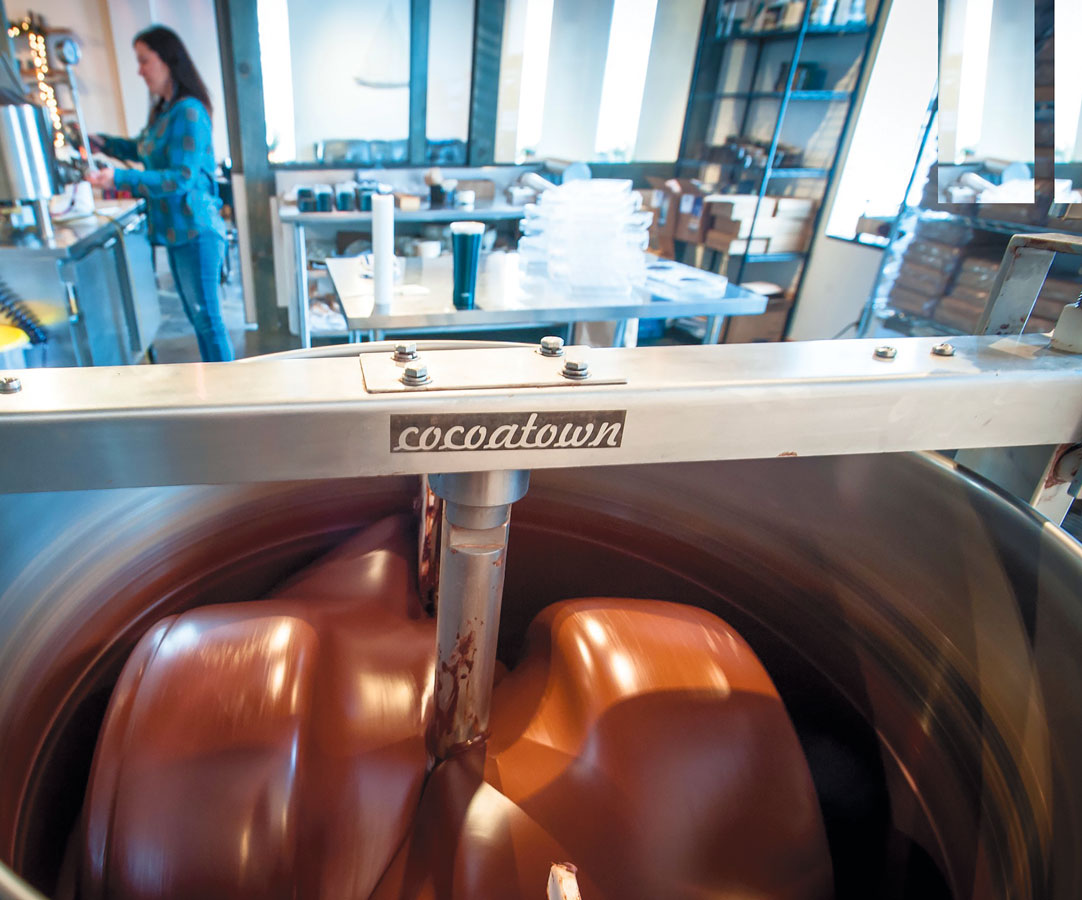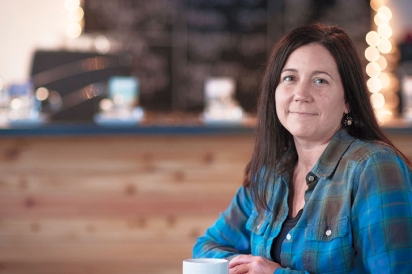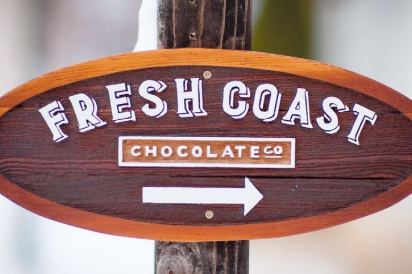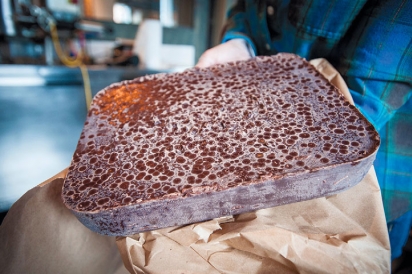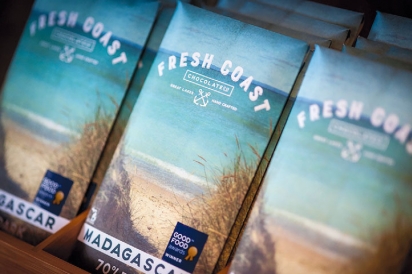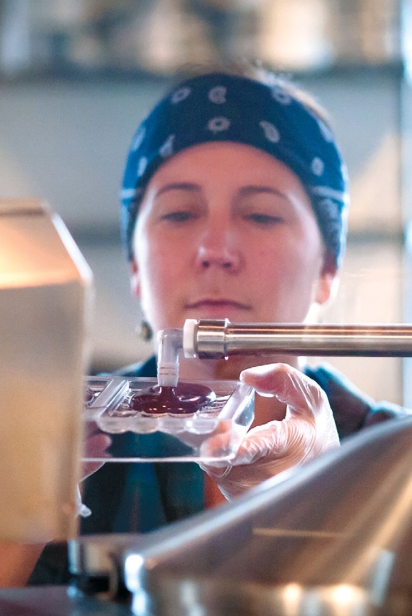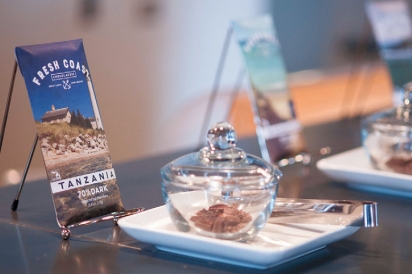Sweet Treats
Raising the Bar on Chocolate: Fresh Coast Takes Fresh Approach
Sitting on the cocoa-colored couch near the slender windows at Fresh Coast Chocolate Company is a treat all by itself. The textured sounds of the workshop, woven with the women working, the machines and music, lend a comforting vibe. Soothing, earthy tones and handsome architecture offer a welcoming feel inside this “bean-to-bar” chocolate factory and café, newly opened in the Warehouse District of Traverse City.
Outside, the winter wind whips through the alley, snow swirling like the delicate spoon in a cup of velvety, handcrafted Fresh Coast drinking chocolate. House-made marshmallow cubes follow the flow and the flavor flaunts a cocoa finish and hints of raspberry and rainforest.
Behind the immaculate glass partition that creates a viewing area from the shop, Fresh Coast Chocolate’s founder and chocolate maker Nichole Warner shakes melting chocolate into a molding tray. She lifts and deliberately drops the tray again and again onto a vibrating machine until the chocolate is even and level in the mold. Neither the intensity of the pulsating machines nor the narrow timeframe of cooling chocolate riles Nichole. In fact, it is this stage of chocolate making when she takes time to think, tossing ambitious ideas around her mind like the cocoa nibs circulating in the melanger machine behind her.
Fresh Coast Chocolate is one of only two bean-to-bar chocolate factories in Michigan. Here they craft chocolate the Old World way: carefully and slowly, over many days.
“I’m kind of a perfectionist,” says Nichole. “I pay attention to detail in every step of the chocolate making process, from sorting beans to packaging.” Nichole indeed has a knack for neatly wrapping chocolate bars in foil and slipping each one into a Great Lakes-inspired envelope without dent or ding. However, her true talent is her ability to turn just two ingredients—organic cacao nibs and pure organic cane sugar—into chocolate bars that retain the complex flavors and terroir of the original beans.
Burlap bags bulging with 120 pounds of cocoa beans are neatly stacked in one of Fresh Coast Chocolate’s workshops, with the beans’ origins proudly printed across the top. For any given batch of chocolate, a single-origin bean is selected and the sack is sorted bean by bean, carefully inspecting for vulnerability in the shell. Too large a gap or crack could allow the cocoa nib, or kernel, inside the bean shell to burn during the roasting process.
While the environment in which the cocoa bean is grown is fundamental to its flavor, it is during the roasting process when the taste takes its final shape.
“We roast each variety of cocoa bean differently to extract its unique flavor profile,” Nichole explains. “Roasting generally takes 20–30 minutes. We are constantly monitoring, raising the heat, then lowering the ambient temperature by opening the oven doors.” High heat at the start is the thermal thrust the bean needs to kick out complementary chemical reactions. Lowering the heat allows for the nibs inside the beans to roast without burning.
After roasting, the cocoa beans are hauled to the hopper of a winnower machine. The winnowing process cracks the beans and separates the nib from the shell, or husk. A vacuum-powered airflow sends the lightweight husks into one container, while the nibs—the chief constituent of chocolate—fall into buckets for small-batch production.
From the winnowing room, the cocoa nibs are transported to a separate work station and poured into the melanger machine. The nibs are ground between large spinning granite stones. The cocoa butter is pulverized out of the nibs and binds with the dry particles until the mixture has a silky-smooth and creamy texture.
“Each harvest, each bean, each batch is different,” Nichole says. “All of our chocolate is refining in the melanger anywhere from three to five days, depending on the astringency. Sometimes the beans come in with more bitterness than the last harvest and it might take longer to work the flavors out.”
At some carefully chosen point during the refining process, Nichole adds pure organic cane sugar to the liquefied nibs. As of now, all of Fresh Coast’s chocolate bars are 70 percent dark. This means that 70 percent of the weight of each bar is cocoa and 30 percent is sugar. “Cocoa content also includes cocoa butter, so our 70 percent bar, being only cocoa beans and sugar, may taste darker than another maker’s 70 percent bar, as their bar may contain 65 percent nib, 5 percent cocoa butter and 30 percent sugar. 70 percent bars can taste quite different from each other.”
The cocoa and cane sugar blend until the chocolate maker’s desired flavor and texture have been met. “The creativity in coaxing out the complex flavor profiles is one of the things that drew me to chocolate making,” Nichole says. “I made it my mission to craft a silky-textured chocolate—a chocolate that, when it comes down to it, I like eating.”
Once the flavor has been declared final, the chocolate is poured into pans and cooled. This untempered chocolate develops a bloom—a dull, blotchy finish with white streaks and spots where the cocoa butter has crystalized. “We like to let our untempered chocolate age for a month or more to let the flavors mellow and meld a bit before tempering,” says Nichole.
Tempering is the art of transforming liquid chocolate into an attractive solid. To temper, chunks of aged, brittle chocolate are placed in a tempering machine. “The tempering process involves first melting the chocolate then raising the temperature to between 115 and 120 degrees to break up the fat and sugar crystals,” Nichole explains. “We then lower the temperature to 82 or 83 degrees with agitation to build the correct crystal formations.”
Pouring the chocolate into molds is also part of the tempering process, but at this point the chocolate is too thick to work with. The temperature is raised slightly to get a workable viscosity for pouring, being careful not to reach temperatures that would change the crystal formations.
Properly tempered chocolate has a glossy, smooth and firm finish, a solid snap when broken and a pleasant texture in the mouth. “Quality and flavor are relatively new in the chocolate world,” says Nichole. “It used to be only commodity cocoa beans, and chocolate made on machines at an industrial level, relying on fillers for flavor.”
The genuine relationships with the farmer, the terroir of the naturally grown cacao and the painstaking patience in the chocolate making process all show up in the complex flavor and exceptional quality of Fresh Coast Chocolate products. Nichole’s made-from-scratch business has received recognition from the Good Food Foundation, which since 2012 has been giving awards for “truly good food—the kind that brings people together and builds strong, healthy communities.”
The awards process includes blind tastings by food experts followed by a thorough business review to ensure the awards go only to the most conscientious and talented craft food producers in the United States. Fresh Coast is a 2016 Good Food Awards winner for their Madagascar 70 percent dark handcrafted chocolate and currently has two entries as finalists for 2017.
“To be a recipient of a Good Food award this year, and to have our Tanzania and Belize bars as finalists for 2017, is incredibly validating and such a huge honor,” Nichole says. “To be recognized alongside the best chocolate makers in the country is both humbling and deeply satisfying.”
Stop in at the factory-café to talk tasting notes or to purchase chocolate bars, raw cocoa nibs and house-made brownie mix. This winter, find a pocket of time to warm up with a friend at Fresh Coast over a mug of handcrafted hot cocoa or café mocha. If you really want to do yourself a favor, order up a cup of warm, satiny, single-origin drinking chocolate and chew on its creation story. There is a cocoa-colored couch by the window awaiting.
IF YOU GO:
Fresh Coast Chocolate
221 Garland St., Suite D, Traverse City
Open Tuesday–Sunday, 10AM–5PM
FreshCoastChocolate.com
Good Chocolate
Chocolate, in all its forms, begins with the cacao (kuh-KAH-oh) tree, Theobroma cacao. Along its trunk the tree produces many large orange pod-like fruits, inside of which are the cacao beans (more commonly referred to as cocoa beans). Fresh Coast Chocolate purchases sustainably grown and ethically sourced cocoa beans from Tanzania, Madagascar, Peru, Brazil and Belize. The fruit is grown and harvested by regional farmers who then network with sourcing companies. One enterprise in particular, Maya Mountain Cacao, has revolutionized the industry by using the “power of relationships and innovation as a business model,” according to Nichole.
“There are people on the ground doing outreach work—teaching farmers how to preserve their heirloom beans and providing assistance with yields,” Nichole says. In addition, the field teams help growers keep up on organic certifications and assist in reforestation efforts. Maya Mountain Cacao prioritizes buying fresh, wet cacao at the farm gates and immediately paying the small growers fair compensation. Sourcing companies, like Maya Mountain Cacao, also have processing teams that care for the bean fermentation and drying process before the beans are shipped to chocolate makers.


